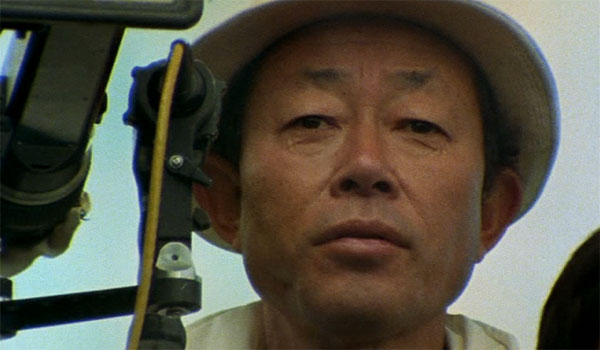“Takao Saito, cameraman on many of Akira Kurosawa’s biggest films, died on Dec. 6 of lymphocytic cancer, aged 85.” Gavin J. Blair for the Hollywood Reporter: “Saito began working with Kurosawa soon after he entered Toho Studio following the end of the Second World War, cutting his teeth on One Wonderful Sunday. He went on to become a member of the so-called ‘Kurosawa-gumi,’ a group of cast and crew that the legendary director collaborated with on many of his films…. The collaboration with Kurosawa was to last for 18 productions over nearly half a century, until the director’s final film Madadayo (Not Yet) in 1993, which won Japan’s Academy Awards for Saito.”
Among the most well-known collaborations with Kurosawa are Sanjuro (1962), Kagemusha (1980), Ran (1985) and Dreams (1990).
Sarah Lawrence College has put together a mini-site in remembrance of “our beloved colleague, teacher, and friend Gilberto Perez. Gil was a brilliant film historian and critic, and a public intellectual of the most profound kind…. His extraordinary book, The Material Ghost: Films and Their Medium (Johns Hopkins, 1998) was acclaimed by scholars and writers from a broad array of disciplines.” Tributes here come from Malcolm Turvey (“he was, quite simply, the best writer in the field”), David Netto (“like many of the smartest people, Gil prized humor highly”), Angel Moger and William Park: “I have long thought Gil Perez’s The Material Ghost the most illuminating book ever written about film and the theory of film.”
Jonathan Rosenbaum remembers his friend as well: “A slow and methodical writer, but also a prolific one, Gil wrote frequently about film for the The Hudson Review, The Yale Review, and the London Review of Books and less often for film and academic journals, and I was often envious of the way he was both welcome and able to hold his own as a public intellectual with a literary sensibility in those and similar venues, such as The Nation…. A very sturdy collection could be made up of those pieces, and he was also working on an ambitious second book about film rhetoric that had been in progress for several years…. He certainly earned the gratitude of Jean-Marie Straub and Danièle Huillet for his ‘Modernist Cinema: The History Lessons of Straub and Huillet’ in the October 1978 Artforum, and when I put together a collection of articles about their films for their only American retrospective to date, in 1982, with Straub and Huillet’s guidance and suggestions, that article was the publication’s centerpiece.”
“Samuel Goldwyn Jr., an urbane, soft-spoken scion of a Hollywood dynasty who became an influential movie executive in his own right, supporting promising young directors and advancing the independent film movement,” has died at the age of 88. Brooks Barnes in the New York Times:
A ravenous book reader, possessing intellectual curiosity in a business not known for it, Mr. Goldwyn was an early champion of stylized, cerebral films that most major studios thought would never sell a ticket. His indie operation, the Samuel Goldwyn Company, founded in 1979, helped create a business model—low production costs, guerrilla marketing—that allowed art-house movies to grow into a powerful cultural and economic force….
[He] was also known for backing budding directors on their early films, including Ang Lee (The Wedding Banquet), Anthony Minghella (Truly Madly Deeply) and Kenneth Branagh (Henry V).
In one of his audacious moves, in 1989, Mr. Goldwyn backed Longtime Companion, a feature film about the impact of the AIDS crisis on the lives of gay men. Some theater owners refused to book it, but Mr. Goldwyn pressed on, releasing a trailer that mentioned AIDS in its first 10 seconds.
“Taylor Negron was part of a generation of versatile comedians who, in the 1970s and 1980s, found a home on TV, in movies, and doing stand-up—even though they sometimes had trouble finding exactly the right venue for their talents,” writes Noel Murray at the Dissolve. “In Negron’s case, he worked steadily from 1980 until his death this past weekend at the age of 57, but his career is defined more by his endurance and his overall presence than by a succession of great roles. He appeared in cult favorites, classic comedies, and a lot of shlock, but whatever the part, Negron himself was always memorable. As a pizza guy in Fast Times at Ridgemont High, as a mailman in Better Off Dead, as a mob goon in The Last Boy Scout, as a comedian in Punchline, and in dozens of other films and TV shows where he often only appeared for a scene or two, Negron stood out.”
Negron was an engaging and funny writer as well, and xoJane has run one of his most well-known pieces: “After 30 years in show business I’ve given up on the idea that people will know my first and last name together, and I’ve accepted that I will never, ever be actually famous. Instead, I am fame-ish.”
More appreciations: Will Harris (AV Club), Erika Schickel (Los Angeles Review of Books) and Barbara Steele (Chiseler).
For news and tips throughout the day every day, follow @KeyframeDaily. Get Keyframe Daily in your inbox by signing in at fandor.com/daily.




